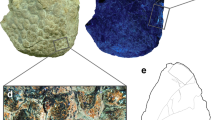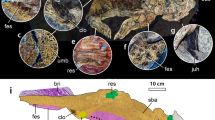Abstract
Preserved skin of small dinosaurs is rare. Here, a specimen of the ceratopsian dinosaur, Psittacosaurus, presents some of the best preserved epidermal scales observed to date in a relatively small dinosaur, over wide areas extending from the head to the tail. We study the preserved epidermis of SMF R 4970, the different types of scales, color, and patterns, and their respective locations in the body. We use modern application of high-power digital imaging for close-up analysis of the tubercles and fragments of preserved color. Three types of scales are preserved, large plate-like scales, smaller polygonal scales or tubercles, and round pebble-like scales. The sizes of the plate-like scales vary in different parts of the body and vanish altogether posteriorly. Light and dark cryptic patterns are created by the associations of the tubercle and plate-like scales, and there is also evidence of countershading in the proximal caudal region, the body darker dorsally and lighter ventrally. Perhaps most impressive are the distinctive pigmented impressions of scales over most of the skeletal elements. The pigmentation follows the curvature of the bones implying that when it was deposited, the skin was still pliable and able to wrap around the visible parts of the elements. The present record of color is the first in a non-theropod dinosaur and only the second record in a non-avian dinosaur. Because of its resistance to degradation and ability to produce various color tones from yellows to blacks, we suggest that melanin was the dominant chemical involved in the coloration of Psittacosaurus. The data here enable us to reconstruct the colors of Psittacosaurus as predominantly black and amber/brown, in cryptic patterns, somewhat dull, but useful to a prey animal. Indeed, skin pigment within a partially degraded bone indicates that Psittacosaurus was scavenged shortly after death. The theropod dinosaur Sinosauropteryx has recently been reported to have naturally pigmented integumental structures, which the authors interpret as proof that they are protofeathers and not support fibers of collagen. Our findings in Psittacosaurus, on the other hand, indicate a more parsimonious and less profound alternative explanation, i.e., decomposition of the skin releases pigments that readily permeate underlying structures.




Similar content being viewed by others
References
Averianov AO, Voronkevich AV, Leshchinskiy SV, Fayngertz AV (2006) A ceratopsian dinosaur Psittacosaurus sibiricus from the Early Cretaceous of West Siberia, Russia and its phylogenetic relationships. J Syst Paleontol 4(4):359–395
Borel P, Grolier P, Armand M, Partier A, Lafont H, Lairon D, Azais-Braesco V (1996) Carotenoids in biological emulsions: solubility, surface-to-core distribution, and release from lipid droplets. J Lipid Res 37:250–261
Czerkas SA (1997) Skin. In: Currie PJ, Padian K (eds) Encyclopedia of Dinosaurs. Academic, San Diego, pp 669–675
Göhlich UB, Chiappe LM (2006) A new carnivorous dinosaur from the Late Jurassic Solnhofen archipelago. Nature 440:329–332
Hagdorn H, Sandy MR (1998) Color banding in the Triassic terebratulid brachiopod Coenothyris from the Muschelkalk of Central Europe. J Paleontol 72:11–28
Heads SW, Martill DM, Loveridge RF (2005) An exceptionally preserved antlion (Insecta, Neuroptera) with color pattern preservation from the Cretaceous of Brazil. Palaeontology 48(6):1409–1417
Hollingworth NTJ, Barker MJ (1991) Color pattern preservation in the fossil record: taphonomy and diagenetic significance. In: Donovan SK (ed) The Process of Fossilization. Columbia, New York, pp 105–119
Ji SA, Bo HC (1998) Discovery of the psittacosaurid skin impressions and its significance. Geological Review 44:603–606
Kobluk DR, Mapes RH (1989) The fossil record, function, and possible origins of shell color patterns in paleozoic marine invertebrates. Palaios 4:63–85
Kriz J, Lukes P (1974) Color patterns on Silurian Platyceras and Devonian Merista from the Barrandian area, Bohemia, Czechoslovakia. J Paleontol 48(1):41–48
Lingham-Soliar T (1999) Rare soft tissue preservation showing fibrous structures in an ichthyosaur from the Lower Lias (Jurassic) of England. Proc R Soc Lond B 266:2367–2373
Lingham-Soliar T (2001) The ichthyosaur integument: skin fibres, a means for a strong, flexible and smooth skin. Lethaia 34:287–302
Lingham-Soliar T (2003) The dinosaurian origin of feathers: perspectives from dolphin (Cetacea) collagen fibers. Naturwissenschaften 90:563–567
Lingham-Soliar T (2005) Dorsal fin in the white shark Carcharodon carcharias: a dynamic stabilizer for fast swimming. J Morphol 263:1–11
Lingham-Soliar T (2008) A unique cross-section through the skin of the dinosaur Psittacosaurus from China showing a complex fibre architecture. Proc Soc B 275:775–780
Lingham-Soliar T, Wesley-Smith J (2008) First investigation of the collagen D-band ultrastructure in fossilized vertebrate integument. Proc R Soc B 275:2207–2212
Lingham-Soliar T, Feduccia A, Wang X (2007) A new Chinese specimen indicates that ‘protofeathers’ in the early Cretaceous theropod dinosaur Sinosauropteryx are degraded collagen fibers. Proc R Soc B 274:1823–1829
Lingham-Soliar T (2010) Response to comments by G. Mayr to my paper “Dinosaur protofeathers: pushing back the origin of feathers into the Middle Triassic?” J Ornithol. doi:10.1007/s10336-009-0475-2
Lingham-Soliar T, Glab J (2010) Dehydration: A mechanism for the preservation of fine detail in fossilised soft tissue of ancient terrestrial animals. Palaeogeography, Palaeoclimatology, Palaeoecology. doi:10.1016/j.palaeo.2010.03.019
Lull RS (1933) A revision of the ceratopsia or horned dinosaurs. Memoirs Peabody Mus Nat Hist 3(3):1–175
Macedonia JM, James S, Wittle LW, Clark DL (2000) Skin pigments and coloration in the Jamaican Radiation of Anolis Lizards. J Herpetol 34(1):99–109
Mapes RH, Davis RA (1996) Color patterns in Ammonoids. In: Landman NH, Tanabe K, Davis RA (eds) Ammonoid Paleobiology. Plenum, New York, pp 104–123
Martill DM, Batten DJ, Loydell DK (2000) A new specimen of the thyreophoran dinosaur cf. Scelidosaurus with soft tissue preservation. Palaeontology 43:549–559
Matthew WD (1915) Dinosaurs with special reference to the American Museum Collections. New York American Museum of Natural History. By permission of Project Gutenberg http://www.gutenberg.org/
Mayr G, Peters DS, Plodowski G, Vogel O (2002) Bristle-like integumentary structures at the tail of the horned dinosaur Psittacosaurus. Naturwissenschaften 89:361–365
Mee-mann C, Chen PJ, Wang YQ, Wang Y (eds.) (2003) The Jehol Biota: the emergence of feathered dinosaurs, beaked birds and flowering plants. Shanghai Scientific & Technical Publishers, Shanghai, 208 pp.
Nitecki MH, Sadlick W (1968) Notable color pattern in a fossil brachiopod. J Paleontol 42(2):403–405
Peyer K (2006) A Reconsideration of Compsognathus from the upper Tithonian of Canjuers, Southeastern France. J Vertebr Paleontol 26(4):879–896. doi:10.1671/0272-4634(2006)26[879:AROCFT]2.0.CO;2
Ruxton GD, Speed MP, Kelly DJ (2004) What, if anything, is the adaptive function of countershading? Anim Behav 68(3):445–451
Taylor LA, McGraw KJ (2007) Animal coloration: sexy spider scales. Curr Biol 17:592–593
Vinther J, Briggs DE (2008) The color of fossil feathers. Biol Lett. doi:10.1098/rsbl.2008.0302
You HL, Tanoue K, Dodson P (2008) New data on cranial anatomy of the ceratopsian dinosaur Psittacosaurus major. Acta Palaeontol Pol 53(2):169–182
Zhang F, Kearns SL, Orr PJ, Benton MJ, Zhou Z, Johnson D, Xu X, Wang X (2010) Fossilized melanosomes and the colour of Cretaceous dinosaurs and birds. Nature 463:1075–1078. doi:10.1038/nature08740
Zheng XT, You HL, Xu X, Do ZM (2009) An Early Cretaceous Heterodontosaurid dinosaur with filamentous integumentary structures. Nature 458:333–336. doi:10.1038/nature07856
Zhou CF, Gao KQ, Fox RC, Chen SH (2006) A new species of Psittacosaurus (Dinosauria: Ceratopsia) from the early cretaceous Yixian Formation, Liaoning, China. Palaeoworld 15:100–114
Acknowledgements
We express our gratitude to Sven Tränkner (Photographer) for the excellent digital images and Olaf Vogel (Preparator) for his skillful work and advice on the preparation of Psittacosaurus SMF R 4970 (both Geology Department, Senckenberg Museum). TLS thanks Kevin McGraw (Arizona State University) for discussions concerning color in vertebrates. We thank three reviewers for their extensive positive advice and encouragement which has benefited the paper substantially.
Author information
Authors and Affiliations
Corresponding author
Additional information
Author contributions
GP—detailed examination of SMF R 4970 with respect to the material’s geology, lithology, preparation, and photography. TL-S—detailed analysis of the integument of Psittacosaurus SMF R 4970 based on digitized images of microstructures, zoological, paleontological and taphonomic interpretations, and writing the paper. This is an equal joint publication.
Electronic supplementary material
Below is the link to the electronic supplementary material.
ESM S1
Psittacosaurus SMF R 4970. High-resolution image of text-figure 2d. Dark plate-like scales surrounded by rings of amber/brown tubercles (white arrows) preserved over bone (proximal part of right scapula—see Fig. 1, circle); the amber/brown hue of the tubercles contrasts with the gray of the bone. Scale bar = 5 mm (GIF 476 kb)
ESM S2
Psittacosaurus SMF R 4970. High-resolution image of text-figure 3e showing the complete left coracoid and well-defined pigment impressions of tubercles (light and dark brown/black), overlying the upper part. Scale bar = 10 mm (GIF 388 kb)
ESM S3
A decomposing juvenile dolphin exhumed after several months burial. The most widespread and brightest pigment preservation overlies bone (white arrows), despite the thick underlying blubber or perhaps aided by it. The pigment is either absent (black arrowheads) or dull when preserved over the soft tissue (white arrowhead) or matrix (JPEG 268 kb)
ESM S4
The scaly skin of a hadrosaur showing worn surfaces of the scales (above) that may obscure fine surface texture and (below) that of Heloderma (gila monster ) showing a pappilose surface (after Matthew 1915) (JPEG 101 kb)
ESM S5
Psittacosaurus SMF R 4970. Right humerus, partial radius, and scapula. The tubercle impressions appear closely “wrapped” around the visible parts of the elements strongly indicative of the plasticity of the skin when this occurred (i.e. before mineralization). Note the stress fractures that subsequently occurred (GIF 771 kb)
ESM S6
Psittacosaurus SMF R 4970. A torn fragment of skin dislodged from adjacent to the vertebrae (top, large arrow) and displaced over the distal tips of the ischium, creasing at this point (indicated by the tubercles becoming sharply attenuated, arrowheads), and pubis. The three-pronged arrow shows rare detail of the torn fibers of a basal meshwork, which hold the scales in place and facilitate their movement (GIF 541 kb)
ESM S7
Psittacosaurus SMF R 4970. Distal part of right radius. A serendipidous fracture shows traces of pigmented scale impressions (arrows) from the torn skin on inner layers of the bone (arrowheads show stains on external surface), during decomposition of the skin. Color leaching from the epidermis to impregnate inner layers of bone could only have occurred shortly after fracture of the bone (i.e., evidence that the fracture was not post fossilization). However, within this fractured area we see a stress crack (detail, curved arrow) cutting across the scale imprint, suggesting that this crack occurred after the tubercle/pigment had become imprinted, possibly during compression. Large arrow shows direction bone was stripped-deepest to shallowest (indicated by numbers 1–4, respectively). The fractured radius gives a clue to circumstances surrounding the animal’s death—it was probably being scavenged at this point (see text). Curved double-headed arrows show possible bite impressions. Scale bar = 2 cm (GIF 293 kb)
ESM S8
George, a fleet-footed breed of hunting dog, Africanus (related to and about the size of a greyhound), descended from the court of the Egyptian pharaohs, shows counter shading, i.e., darker dorsal and lighter ventral parts of the body, including the tail, but lightening in an antero-posterior direction in the hind legs. George also demonstrates well cryptic markings that break up the body color (owned by Mrs Anne Knott—photo, Theagarten Lingham-Soliar) (JPEG 272 kb)
Rights and permissions
About this article
Cite this article
Lingham-Soliar, T., Plodowski, G. The integument of Psittacosaurus from Liaoning Province, China: taphonomy, epidermal patterns and color of a ceratopsian dinosaur. Naturwissenschaften 97, 479–486 (2010). https://doi.org/10.1007/s00114-010-0661-3
Received:
Revised:
Accepted:
Published:
Issue Date:
DOI: https://doi.org/10.1007/s00114-010-0661-3




